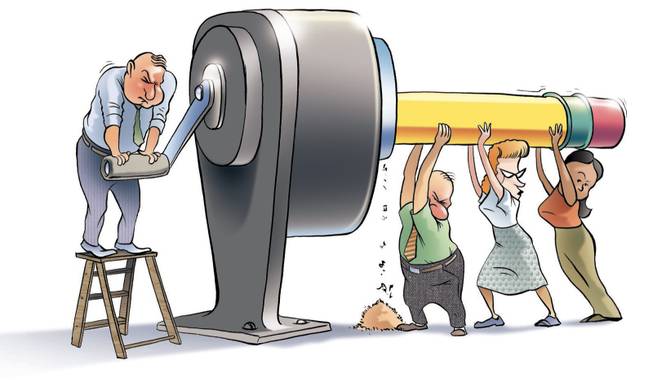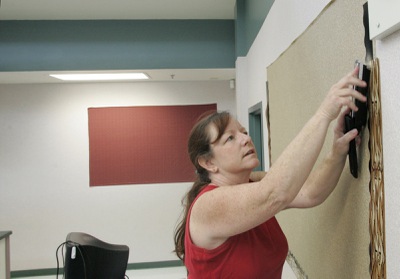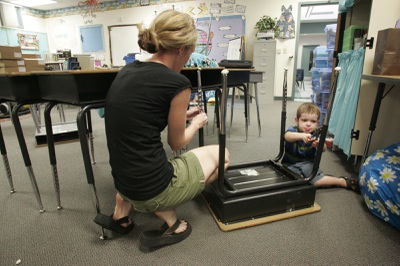Friday, Aug. 15, 2008 | 2 a.m.
Reader poll
When an office supply store offered folders for a penny, second-grade teacher Nikki McCormick bought as many as the store would allow: 10.
She made four trips to the store, and did the same when the sale was on 1-cent erasers (limit 12). All summer long she has been ferreting away supplies — pencils, crayons and paper — materials many schools will be rationing when students return Aug. 25.
“I’m very committed to making sure my kids have what they need,” said McCormick, who is entering her 30th year as a teacher and 16th in the Clark County School District. “I don’t care how many trips I have to make to OfficeMax.”
During June’s special legislative session, lawmakers cut by half the funding for school instructional supplies, including textbooks, paper and pencils.
“The schools probably cannot operate given how deeply we cut them,” said Jim MacIntosh, the district’s deputy chief financial officer.
Officials are planning to restore about $14 million for school supplies by making steeper cuts to administrative office budgets, he said. But the extra money won’t be available until October, which means campuses will have to be thrifty in the first few months of the academic year.
At Tony Alamo Elementary, Principal Rod Kissinger saw his school’s initial allocation, which represents 75 percent of its annual allotment for instructional supplies, drop to $45,000 from $104,000.
As a result, copier paper will be rationed based on the number of students in each class, and access to the color printers will be restricted. Once-basic supplies, such as watercolor paints, glue sticks and label writers, will not be ordered.
“There is going to be an impact to the cuts at our school,” Kissinger said. “But we want to assure parents the needs of their children are being met.”
Alamo first grade teacher Jennifer Szemety said she has looked over lesson plans for the first few weeks of school, hunting for ways to cut down on photocopying.
“We’re going to have to be more creative,” said Szemety, who is entering her 10th year as a teacher. “Do I really need to do this activity that’s going to require 200 sheets of paper, or can I teach the same concept in a different way?”
Teachers will still receive $200 purchasing cards from the district. But those funds will now likely be spent on basics that were once provided by schools. That means less money for the extras, such as the modest prizes teachers use as incentives for improved behavior or perfect attendance.
Many teachers say they are prepared to dip deep into their own pockets and expect to spend upward of $100 a month to keep their classrooms stocked.
But one thing Clark County schools won’t be doing is pressuring families to make up the supplies shortfall. There have been several warnings to that effect, at the district, region and school level.
In a letter to his teachers, Kissinger repeated the district’s request that schools “demonstrate sensitivity to families when requesting donated items or supplies.”
Any request sent to parents, Kissinger said, should include this statement: “The Clark County School District provides students with the essential school supplies. However, many children enjoy bringing supplies to school. You are welcome to purchase any of the items listed below.”
The list includes paper towels, rulers, child-safe scissors and crayons.
“The economy has not just hit the district,” said Jolene Wallace, superintendent of the southwest region. “We have people losing their homes and their jobs. We don’t want schools passing on all of these problems to the parents.”
With schools getting less money for supplies, Wallace said she has tapped her administrative budget to help make up the difference. She’s ordered enough copier paper to give each campus an extra 40 cases as well as dry-erase markers.
“You have to satisfy the needs at the level where the children are,” Wallace said. “If that means cutting something out of the region office, we’re going to bite the bullet and do it.”
At the same time, parents have already been generous, Wallace said.
The southwest region will also start an online swap meet, where teachers and administrators can list items collecting dust in supply closets that could be used at another school.
With the new academic year 10 days off, district officials are working hard to paint a positive picture.
But officials say the lack of money for supplies is just one more blow to school budgets that have already been pared down.
In addition to the money for instructional supplies, $18 million for school improvement and innovation grants was also eliminated. Wallace said the grants, used for remedial reading programs, tutoring and teacher training, among other things, were helping improve student achievement.
“This is going to hurt us,” Wallace said of the budget cuts. “And that’s just really sad.”




Join the Discussion:
Check this out for a full explanation of our conversion to the LiveFyre commenting system and instructions on how to sign up for an account.
Full comments policy